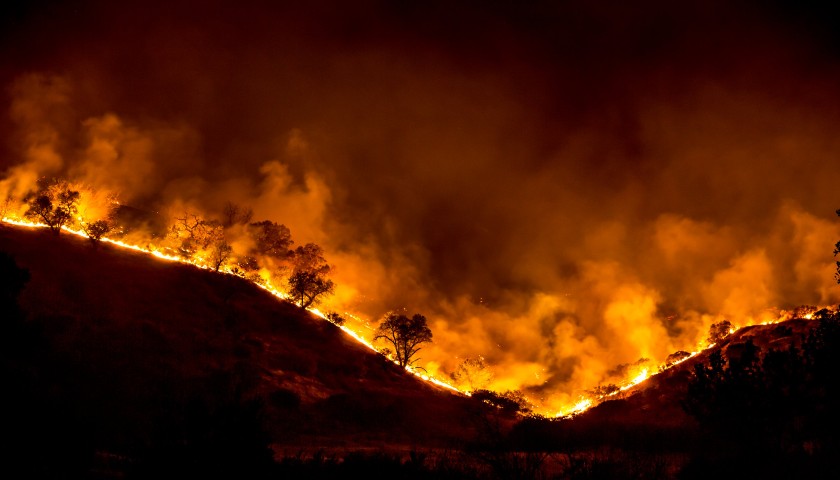by Edward Ring
If this seems like an unfair title, it isn’t, though some of these tyrants were appointed by elected politicians. And all of these tyrants rely on laws that were passed by elected politicians. But while there is plenty of blame to go around, tyranny is what Californians have endured. A tyrannical system is entirely to blame for apocalyptic fires that are wiping out California’s forests, fouling the air, and killing everything in their path.
So who are these unelected tyrants?
We can start with federal and state bureaucrats. Principal among them are the careerist ideologues who dominate the U.S. Environmental Protection Agency, abetted by the fanatics who run California’s Air Resources Board, along with dozens of other federal and state agencies. Joining them outside of government to assist in the incineration of California’s precious ecosystems are the lobbyists and litigants representing powerful environmentalist nonprofits such as the Sierra Club and the Center for Biological Diversity.
So numerous they escape individual accountability, these tyrants collectively have made it nearly impossible to engage in logging, forest thinning, or controlled burns. The policies, regulations, and judgments these tyrants relentlessly advocate and ruthlessly enforce are the reason California’s fires in recent years have been cataclysmic.
As a consequence, after more than a century of increasingly effective suppression of natural fires, California’s forests are now overgrown tinderboxes. They’re either going to get cleared out mechanically, or they’re going to burn like hell.
Opposing this tyranny does not signify a lack of concern for our natural environment, even though the tyrants routinely make the accusation. If you’ve ever been stirred by the sight of a California condor soaring above the wave-battered cliffs of Big Sur, you should thank an environmentalist. Most Californians agree that the condor, along with other species, was worth saving. But if the entire Ventana Wilderness is incinerated, condor habitat no longer exists. Similarly, if the entire Feather River watershed is reduced to cinder, hundreds of square miles of owl habitat will no longer exist.
By now, one may hope, most honest environmentalists know that when it comes to forest management, they’ve blown it. To paraphrase an old adage, they burned down the forest to save the trees. Maybe now they’ll help push for genuine, far-reaching, and swift reform. Then again, a lot of power and money can be had in perpetuating conflict. And recent actions by California Governor Gavin Newsom offer zero indication that help could be forthcoming from politicians. Newsom’s reaction to the ongoing inferno in California is to ban gasoline-powered cars, and declare that he has “no more patience for climate deniers.”
Let’s settle the climate “denier” issue straight away. If California’s summers are getting hotter, dryer, and lasting longer, then everything these unelected tyrants have been doing has been even more misguided, not less. And comprehensive regulatory reform and relief to start properly managing California’s forests is more urgently needed, not less.
So enough about the climate. Acknowledging climate change, regardless of its cause or trajectory, makes the case for forest management reform stronger, not weaker.
It is a great irony that alarm over climate change is used to justify endless proposals that call for urgent and unprecedented actions across all aspects of public policy, yet it cannot stimulate a swift and effective response to California’s burning forests. So what steps can be taken to quickly mitigate the damage of these catastrophic fires? And what ongoing steps can be taken to prevent them in the future?
In preparing this report, expert opinions were solicited from leaders in the timber, cattle, and biomass industries, professional foresters, and political representatives. All of them were in general agreement on the steps to be summarized here. None of them wanted to be quoted directly. The ire of the tyrants is real, and if you’re in these businesses, the power they wield is to be feared.
How to Revive California’s Forests
For about 20 million years, California’s forests endured countless droughts, some lasting centuries. Natural fires, started by lightning and very frequent in the Sierras, were essential to keep forest ecosystems healthy. In Yosemite, for example, meadows used to cover most of the valley floor, because while forests constantly encroached, periodic fires would wipe them out, allowing the meadows to return. Across millennia, fire-driven successions of this sort played out in cycles throughout California’s ecosystems.
Also for the last 20 million years or so, climate change has been the norm. To put this century’s warming into some sort of context, Giant Sequoias once grew on the shores of Mono Lake. For at least the past few centuries, forest ecosystems have been marching into higher latitudes. In the Sierra Foothills, the oaks have invaded the pine habitat, and the pine, in turn, has invaded the higher elevation stands of fir.
Today, it is mismanagement, not climate change, that is the primary threat to California’s forests.
In a speech before the U.S. Congress last September, Republican Tom McClintock summarized the series of mistakes that are destroying California’s forests. McClintock’s sprawling 4th Congressional District covers 12,800 square miles, and encompasses most of the Northern Sierra Nevada mountain range. His constituency bears the brunt of the misguided green tyranny emanating from Washington, D.C. and Sacramento. Here’s some of what McClintock said:
Excess timber comes out of the forest in only two ways—it is either carried out or it burns out. For most of the 20th century, we carried it out. It’s called “logging.” Every year, U.S. Forest Service foresters would mark off excess timber and then we auctioned it off to lumber companies who paid us to remove it, funding both local communities and the forest service. We auctioned grazing contracts on our grasslands. The result: healthy forests, fewer fires and a thriving economy. But beginning in the 1970s, we began imposing environmental laws that have made the management of our lands all but impossible. Draconian restrictions on logging, grazing, prescribed burns and herbicide use on public lands have made modern land management endlessly time-consuming and ultimately cost-prohibitive. A single tree thinning plan typically takes four years and more than 800 pages of analysis. The costs of this process exceed the value of timber—turning land maintenance from a revenue-generating activity to a revenue-consuming one.
When it comes to carrying out timber, California used to do a pretty good job. In the 1950s the average timber harvest in California was around 6 billion board feet per year. The precipitous drop in harvest volume came in the 1990s. The industry started that decade taking out not quite 5 billion board feet, and by 2000 the annual harvest had dropped to just over 2 billion board feet. Today, only about 1.5 billion board feet per year come out of California’s forests as harvested timber.
Reviving California’s Timber Industry
What McClintock describes as a working balance up until the 1990s needs to be restored. In order to achieve a sustainable balance between natural growth and timber removals, California’s timber industry needs to triple in size. If federal legislation were to guarantee a long-term right for timber companies to harvest trees on federal land, investment would follow.
The following map shows the locations of California’s 29 remaining sawmills, along with the locations of eight more that are inactive. In addition, there are 112 sites in California where sawmills once operated. In most cases, these vacant sites of former mills are located in ideal areas to rebuild a mill and resume operations.
The economics of reviving California’s timber industry are compelling. A modern sawmill with a capacity of 100 million board feet per year requires an investment of $100 million. Operating at a profit, it would create 640 full-time jobs. Constructing 30 of these sawmills would create roughly 20,000 jobs in direct employment of loggers, haulers, and mill workers, along with thousands of additional jobs in the communities where they are located.
The ecological impact of logging again in California’s state and federal forests will not become the catastrophe the environmentalists and regulators have suggested as their pretext to destroy the logging industry. Especially now, with decades of accumulated experience, we know that logging does more good than harm to forest ecosystems. There is evidence to prove this.
In forests managed by Sierra Pacific, for example, owl counts are higher than in California’s federally managed forests. Even clear-cutting, because it is done on a 60 to 100-year cycle, does more good than harm to the forests. By converting one or two percent of the forest back into meadow each year, areas are opened up where it is easier for owls to hunt prey. Also, during a clear cut, the needles and branches are stripped off the trees and left to rejuvenate the soil. The runoff is managed as well, via contour tilling which follows the topography of the hillsides. Rain percolates into the furrows, which is also where the replacement trees are planted.
While clear-cutting would not destroy most ecosystems, since it is only performed on one to two percent of the land in any given year, there are other types of logging that can be used in areas deemed more ecologically sensitive. Southern California Edison owns 20,000 acres of forest around Shaver Lake in Southern California where the utility practices what is called total ecosystem management.
When the Creek Fire burned, earlier this year, an almost unthinkable 550 square miles in Southern California, the 30 square-mile island of SCE-managed forest around Shaver Lake was unscathed. The reason is that for decades, Edison has been engaged in timber operations the company defines as “uneven age management, single-tree selection,” whereby the trees to be harvested are individually designated in advance, in what remains a profitable logging enterprise. Controlled burns are also an essential part of SCE’s total ecosystem management, but these burns are only safe when the areas to be burned are caught up on logging and thinning.
The practice of uneven age management could be utilized in riparian canyons, or in areas where valuable stands of old-growth merit preservation. The alternative, a policy of hands-off preservation, has been disastrous. Tree density in the Sierra Nevada is currently around 300 per acre, whereas historically, a healthy forest would only have had around 60 trees per acre. Clearly this number varies depending on forest type, altitude, and other factors. Overall, however, California’s forests, especially on federal lands, contain about five times the normal tree density. The result is trees that cannot compete for adequate moisture and nutrients, much less rain percolating into springs and aquifers, disease and infestation of the weakened trees, and fire.
The choice before us—thin the overgrown forests or suffer fires that destroy the forests entirely—cannot be emphasized enough. In the Feather River Canyon, along with many other canyons along the Sierra Nevada, the east-west topography turned them into wind tunnels that drove fires rapidly up and down the watershed. Yet these riparian areas have been among the most fiercely defended against any logging, which made those fires all the worse. The choice going forward should not be difficult. Logging and forest thinning cannot possibly harm a watershed as much as parched forests burning down to the soil, wiping out everything.
Growing California’s Biomass Power Industry
If removing trees with timber operations is essential to return California’s forests to a sustainable, lower density of trees per acre, mechanical removal of shrub and undergrowth is an essential corollary, especially in areas that are not clear cut. Fortunately, California has already developed the infrastructure to do this. In fact, California’s biomass industry used to be bigger than it is today, and can be quickly expanded.
The next map shows the locations of 22 active biomass power plants in California, generating just over a half-gigawatt of continuous electric power. That’s one percent of California’s electricity draw at peak demand; not a lot, but enough to matter. Also shown on the map are the locations (blue highlighted) of idle biomass plants. Mostly developed in the 1980s and ’90s, at the peak there were 60 biomass power plants in California, but with the advent of cheaper natural gas and cheaper solar power, most of them were shut down.
If removing trees with timber operations is essential to return California’s forests to a sustainable, lower density of trees per acre, mechanical removal of shrub and undergrowth is an essential corollary, especially in areas that are not clear cut. Fortunately, California has already developed the infrastructure to do this. In fact, California’s biomass industry used to be bigger than it is today, and can be quickly expanded.
The next map shows the locations of 22 active biomass power plants in California, generating just over a half-gigawatt of continuous electric power. That’s one percent of California’s electricity draw at peak demand; not a lot, but enough to matter. Also shown on the map are the locations (blue highlighted) of idle biomass plants. Mostly developed in the 1980s and ’90s, at the peak there were 60 biomass power plants in California, but with the advent of cheaper natural gas and cheaper solar power, most of them were shut down.
At a fully amortized wholesale cost estimated somewhere between 12 cents and 14 cents per kilowatt-hour, biomass power plants cannot compete with most other forms of energy. But this price is not so far out of reach that it could not be subsidized using funds currently being allocated to other forms of renewables infrastructure or climate change mitigation. The numbers could work.
If, for example, biomass power capacity in California were roughly doubled to 1 gigawatt of continuous output, a six cents per kilowatt-hour subsidy would cost about $500 million per year. This must be compared to the annual cost of wildfires, which easily exceeds a billion per year. It also must be compared to the amount of money being thrown around on projects far less urgent than rescuing California’s forest ecosystems, such as the California High-Speed Rail project, which has already consumed billions. And if this entire subsidy of $500 million per year were spread into the utility bills of all Californians, it would only amount to about a 1.5 percent increase.
Will the Unelected Tyrants Relent?
The logic of these steps seems impeccable. Thin the forests. Restore them to ecological health. Adopt time-tested modern logging practices and revive the timber industry. Build biomass power plants on the perimeter of the forests. Prevent ridiculous, costly, horrific, tragic wildfires. Help the economy.
But these steps have been known for decades, and yet nothing has been done. Every time policymakers were close to a consensus on forest thinning, government bureaucrats obstructed the process and environmentalists sued to stop the process. And they won. Time and time again. And now we have this: millions of acres of scorched earth, air so foul that people couldn’t leave their homes for weeks, and wildlife habitat that in some cases likely will never recover. If this failure in policy doesn’t leave Californians livid, nothing will.
The forest management policies currently adopted in California have not only ruined the environment they were designed to supposedly protect. They have destroyed California’s timber industry, neglected its biomass industry, and are systematically turning mountain communities into ghost towns. This is tyranny, and perhaps even worse—it is tyranny that lacks either benevolence or wisdom.
If the goal was to have a healthy forest ecosystem, that was violated, as these forests burned to the ground and most of the remaining tracts of unburned forest are overgrown and dying. If the goal was to do anything in the name of fighting climate change and its impact on the forests, and do it with urgency, that too was violated, because everything they did was wrong. Even now, instead of urgent and far-reaching changes to forest management policies, we get more electric car mandates. That was the urgent response.
So California’s ruling elites, starting with Gavin Newsom among the politicians, and Ramon Cruz, the Sierra Club’s new president, can prove they care about the environment by sitting down with representatives from California’s timber industry, along with the unelected state and federal regulators to devise a plan.
Or they can continue to bloviate about “climate change,” unconcerned that climate change only makes it more urgent that California revive its timber and biomass industries.
– – –
Edward Ring is a senior fellow of the Center for American Greatness and co-founder in 2013 of the California Policy Center.
Photo “California Wildfire” by Forest Service, USDA.






Hoping and praying for the best for our future
Excellent article, thank you! I’ve lived in California all my life and the author has hit the nail on the head here.